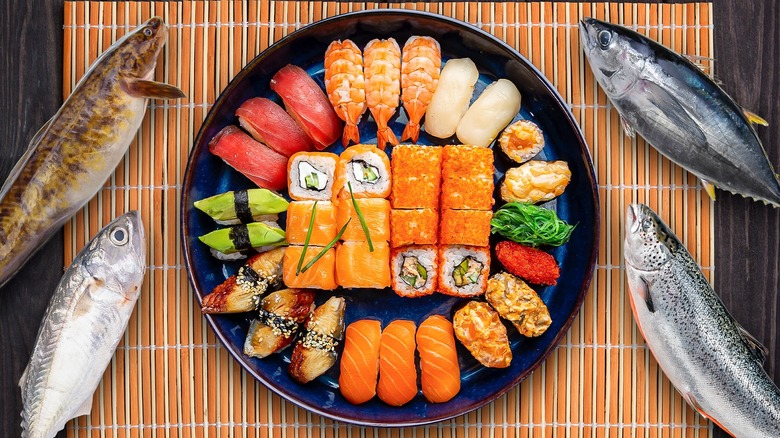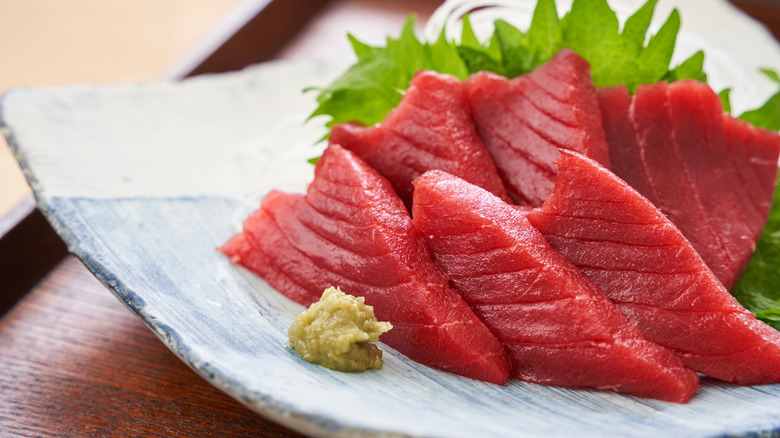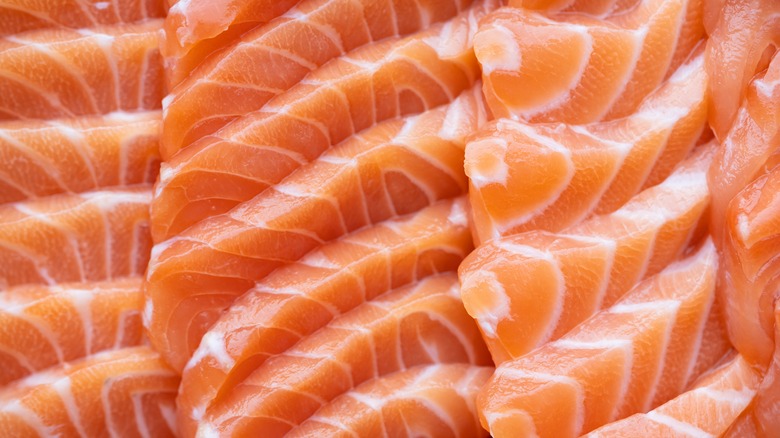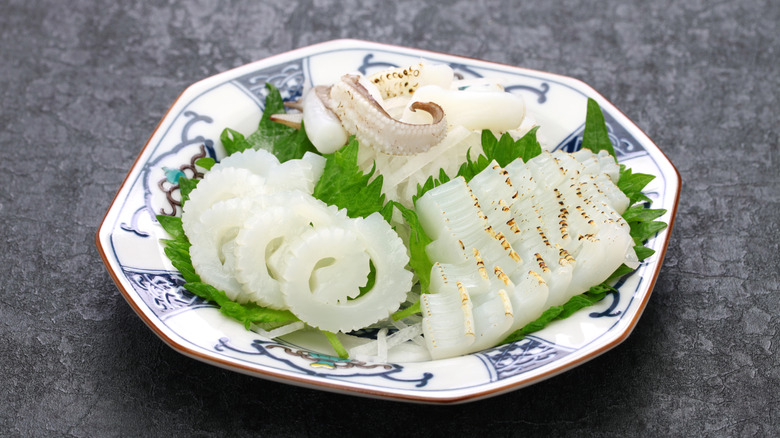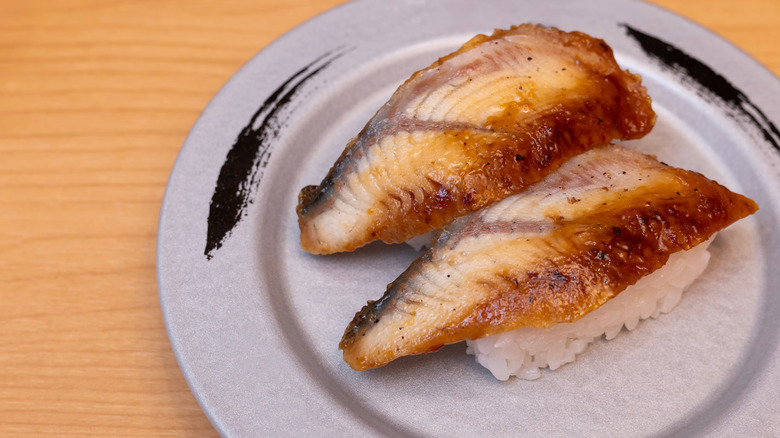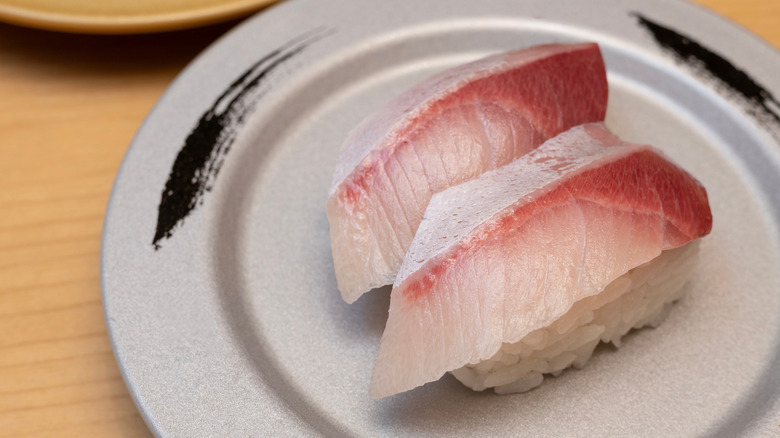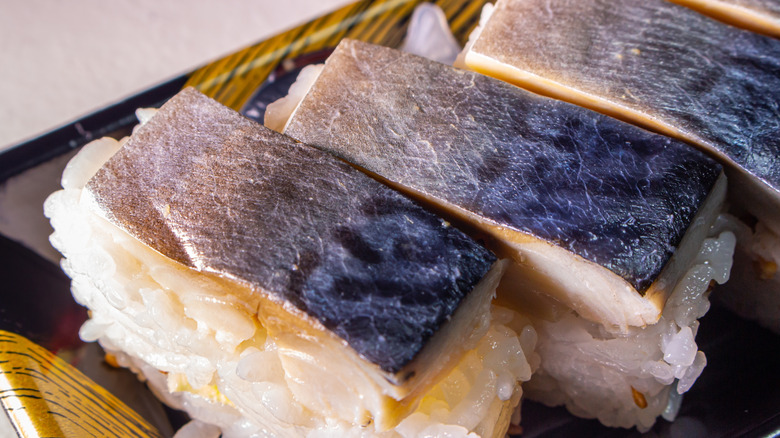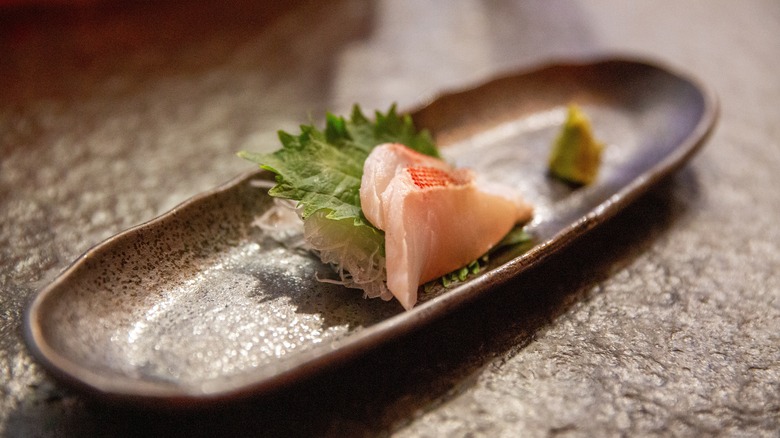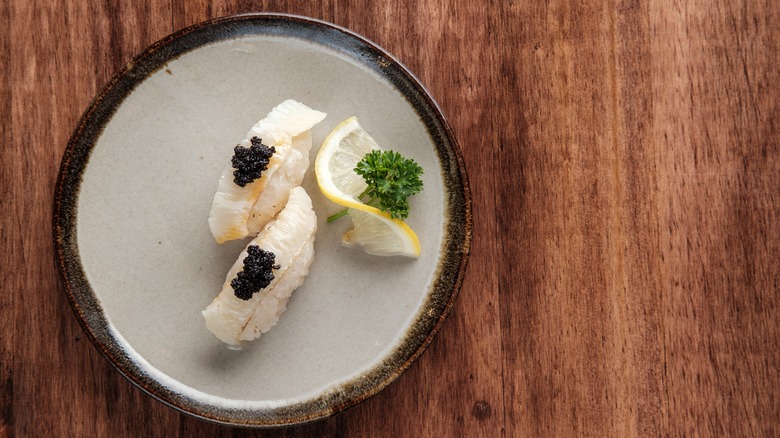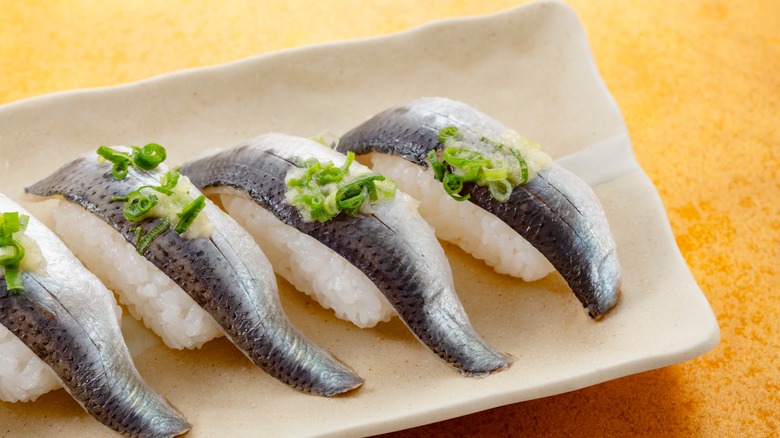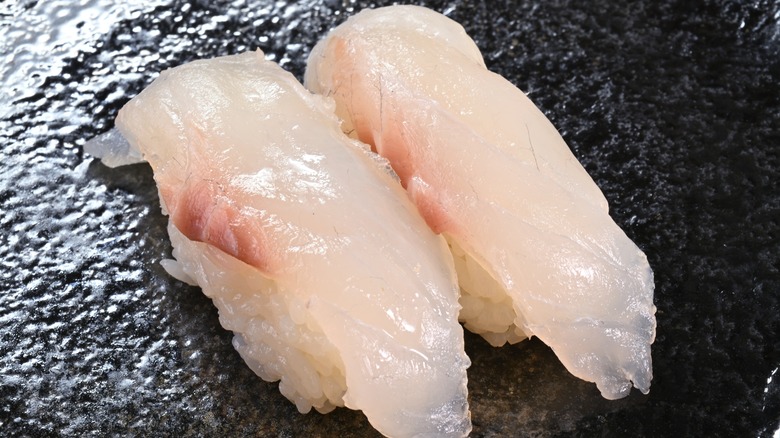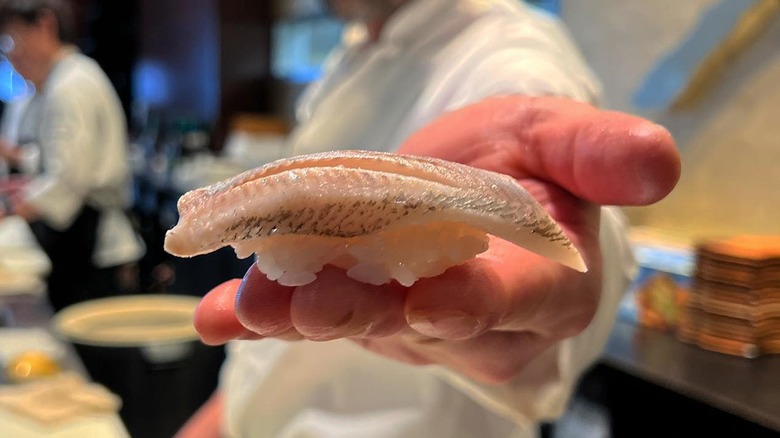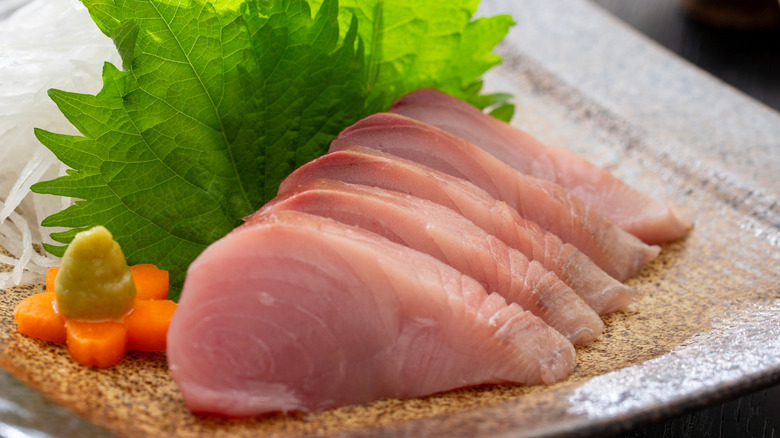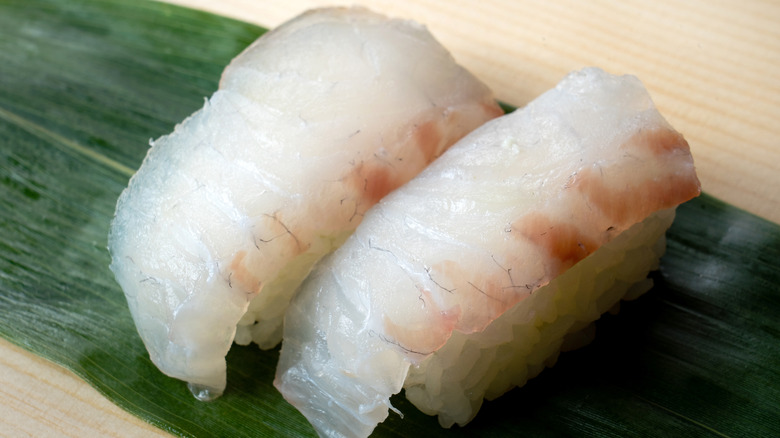14 Common Fish You'll Always See On Sushi Menus
Coming from a family of Japanese chefs, I've definitely been around the chopping block when it comes to sushi. My earliest memories were watching close relatives reel in loads of fish off the coast of Hokkaido in Northern Japan — and then fileting them effortlessly for the perfect bite of sushi. Nothing beats the taste of freshly sliced raw fish with a bit of soy sauce on the side.
Due to my upbringing, ordering at sushi bars was always a breeze. Although, I do realize it can be pretty scary to sit down at a sushi bar, especially if you're not a pro when it comes to the etiquette of eating and ordering sushi.
Before you begin your sushi journey, you should know about the three menu options you'll always find at sushi restaurants: sashimi, nigiri, and sushi rolls (usually called makizushi or maki for short). Sashimi is simply slices of raw fish whereas nigiri is sliced raw fish served on top of a small portion of rice. Maki are sushi rolls that are wrapped in seaweed filled with fish, vegetables, or various other ingredients. If you're looking to expand your knowledge, these are some menu names you should be familiar with.
Now that you've got the basics covered, try heading to your local sushi bar and bring this list as a little cheat sheet. Here are 14 common fishes you'll always see on sushi menus.
Pacific bluefin tuna
Pacific bluefin tuna (not to be confused with yellowfin tuna) is a staple piece of fish found on practically every sushi menu in the world. Known for its shimmering body and world-renowned succulent meat, the Pacific bluefin tuna is one of the largest, fastest, and most prized tuna varieties for sushi connoisseurs.
A fully matured Pacific bluefin tuna is absolutely astonishing. They can be up to 10 feet long and weigh around half a ton. It has a wide range of territory and spawns in temperate waters outside of Japan and the Philippines. They also migrate over 5,000 miles to the warm water of Baja California, Mexico.
Considered a jewel of the ocean amongst sushi chefs, the fish is segmented into two parts: the akami and toro. The akami is the lean red meat found on the upper back of the tuna. This cut is the most popular amongst restaurants due to its low cost and high yield per fish.
Toro is the outer layer and belly of the tuna. This fatty, flavorful area contains the most treasured cuts of tuna and sushi like the famous otoro. This cut is extremely sought after due to its luxurious marbling and exquisite taste. Eating a slice of otoro sashimi will turn you into a sushi fanatic instantly.
Atlantic salmon
Alongside Pacific bluefin tuna, Atlantic salmon is one of the most common fishes used in sushi restaurants. Occasionally referred to on menus as taiseiyosake or sake in Japanese, salmon is extremely affordable and has a high yield of meat per fish, making it a fan favorite amongst sushi chefs.
It's native to the waters surrounding North America, the Baltic Sea, and Scandinavia. Farmed in the fjords of Norway, the country is the biggest farmed Atlantic salmon producer, accounting for over 50% of the world's salmon production. After processing, the salmon fillets are flown across the globe to fish markets like the famous Toyosu market in Japan and the Yama sushi marketplace in Los Angeles.
On sushi menus, you can find salmon as sashimi, nigiri, or makizushi. When served raw, salmon has a mild buttery flavor and soft, chewy texture. Atlantic salmon nigiri is the perfect juxtaposition of flavors between the vinegary, sticky sushi rice and delicate fatty salmon. If you're just jumping into the marvelous world of sushi for the first time, Atlantic salmon is a great choice to ease yourself into eating raw fish. Try starting with a colorful salmon avocado poke bowl to truly test the waters.
Cuttlefish
The cuttlefish is mostly seen on high-end sushi restaurant menus, although rarely ordered. Often mistaken as a fish due to its name, the cuttlefish is actually a mollusk, categorized in the same family as oysters, squids, and octopuses. With a similar appearance and taste to squid, in Japan and abroad both species can be referred to as ika on menus.
Found in Indo-Pacific waters, the expensive kisslip cuttlefish is the most sought-after type of cuttlefish. It is called mongou ika on menus and is often secretly replaced with the cheaper European common cuttlefish or the Jumbo flying cuttlefish. The kisslip cuttlefish has a distinctive sweet taste, so some restaurants may soak the other cuttlefish species in sugary water to obtain a similar flavor. This unacceptable practice is frowned upon in the sushi industry.
Cuttlefish is usually served as a nigiri paired with shiso leaf or ooba, bitter mint-like Japanese herbs, to balance out the flavor. It must be served fresh or else the sweetened flavor will have the texture of an old rubbery eraser or an overcooked chewy clam.
Freshwater eel
Freshwater eel — also known in Japanese as unagi —is an absolute must-try on sushi menus. Freshwater water eel is basted with a delectable sauce called unagi no tare in Japanese, which is made from a concentrated mixture of soy sauce, sugar, mirin, and sake. It is always flame-broiled under a grill before serving because it is unsafe to eat raw. Since it's technically cooked sushi, it's an excellent option for diners looking to steer away from raw seafood.
Freshwater eel has an extremely high fat content, resulting in a rich, buttery flavor that will completely melt in your mouth. Unlike its counterpart, saltwater eel (or anago) has a leaner and milder flavor with a fluffy texture. Both options are great — although freshwater eel is far more popular due to its succulent meat. The juicy interior and crispy, slightly burnt surface will make this your new favorite choice at the sushi bar.
Albacore tuna
Canned tuna lovers will be happy to know they can find their beloved fish fresh on grocery store shelves and sushi menus. While not typically served as sashimi, albacore's soft pink and white flesh is used as topping on rolled sushi or nigiri. Due to its low cost, albacore tuna is popular with conveyor belt sushi restaurants.
You might have seen this moving around the belt listed under the name bintoro, shiro maguro, or white tuna. The fish has a fairly firm texture with a very mild fishy flavor. Unlike expensive otoro tuna, albacore tuna is lower in cost and is much easier to find in fish markets.
In contrast to its much larger cousin, Pacific bluefin tuna, albacore is the smallest tuna species. It usually weighs only a mere 88 pounds and with a torpedo-shaped body that can grow up to 48 inches in length. With a subtle taste usually described as "clean," it's a gentle way to ease into eating sushi.
Yellowtail
It's a common mistake to confuse the yellowtail with the yellowfin tuna due to their similar names even though they're completely different types of fish. Yellowtail, or hamachi in Japanese, is actually an amberjack fish hailing from the Carangidae family. The fish is rarely sold wild-caught as the majority of it is largely farm-raised in Japan and shipped throughout the world. Similar to its tuna counterpart, its name is derived from its vibrant yellow body and tail.
Besides the yellowtail's elegant exterior, the flesh has a distinct mildly pink, white color. The fish has a slightly firm texture with a lighter yet fatty taste. It's traditionally served as a nigiri or sashimi with a splash of ponzu — a citrus-based soy sauce — accompanied by a side of grated daikon radish.
Some sushi restaurants may have negihama on the menu, a rolled sushi that has a combination of minced scallion and yellowtail tightly wrapped in nori. Yellowtail is definitely worth a try if you're craving a more delicate option at the sushi bar.
Pacific mackerel
Pacific mackerel (referred to as saba) is another common fish you'll always see on sushi menus. It's often overlooked compared to the comforting classics like tuna, salmon, or seabream — even though it's one of the most popular choices in Japan. Pacific mackerel is classified under the shiny silver-skinned fish category called hikarimono in Japanese. There are a few different varietals commonly found on menus like the Japanese horse mackerel and Spanish mackerel. However, Pacific mackerel is the most common on sushi menus.
Due to the short shelf life of the fish, it was common to prepare the fish using a technique called shime-saba, in which the mackerel is marinated with a salt and rice vinegar mixture. This technique is still widely used throughout many sushi restaurants, giving the mackerel a strong salty profile.
However, you can also find it without the salt brine called saba. This cut showcases the fish's subtle sweet notes, alongside the true essence of the fish's fatty, oil flavor. Either way, you can't go wrong with trying both shime-saba and saba nigiri to get the best of worlds.
Striped sea bass
Striped sea bass is an Atlantic sea bass species known for its prominent dark grey stripes and mild, sweet flavor. It's found on sushi menus throughout the United States under the name suzuki — even though in Japan suzuki refers to its more expensive cousin Japanese sea bass.
If you order suzuki sashimi or nigiri in the United States, you'll most likely end up with striped sea bass. Despite this fact, the extremely popular fish has a mild, briny flavor with a very light fishy taste
Striped sea bass has a definite firm texture; however, the belly cut tends to be a bit more tender. It is often served as nigiri with a dot of wasabi underneath the fish, a dash of ponzu on top, and garnished with sliced scallions. If you're still a bit hesitant regarding raw fish, this preparation of striped sea bass will get you hooked.
Bastard halibut
Bastard halibut, known as hirame in Japanese, is a fairly common option seen on menus in sushi joints. It's considered a shiromi, a white flesh fish category that includes sea bream as well.
In autumn and spring, the bastard halibut turns into kanbirane, meaning cold hirame. The fish is found along the Russian Chishima Islands all the way to the southern Japanese island of Kyushu. It's harvested just before spawning, during which the fish has an extremely high fat content.
The delicious fatty meat is complemented by its beautiful opaque white flesh. During this period, the price of the fish almost doubles, and sushi fanatics are willing to pay a high price to try a taste of its succulent marbled meat. Besides the legendary season of kanbirane, the bastard halibut species is readily used year-round in sushi making. Bastard halibut's high-quality taste is well-known for its lingering sweet flavor and a firm yet subtly chewy texture.
Sardine
Ordering sardines at the sushi bar may sound unexciting; however, they taste remarkably different outside of their classic canned state. Classified as sliver-skinned fish, sardines are one of the tiniest fishes in the category.
Their extremely fragile body requires immense knife skills to get a presentable filet for sashimi or nirgi. During transportation, it's easy for the sardine's intestines to quickly disintegrate, causing the fish to go rancid. That's why sushi chefs use a similar preparation as mackerel by salting and marinating it in vinegar to keep it fresh.
Some high-end sushi restaurants that have access to fresher sardines may serve it without the salt brine. A typical preparation is to simply add a bit of grated ginger in between the fish and the rice, showcasing the sardine's exquisite taste and texture. Sardines have a delectable sweet, oily flavor and, when served raw, the flesh will completely melt in your mouth. The oily fish, vinegared sushi rice, and zesty grated ginger suit each other perfectly.
Sea bream
Sea bream also referred to as tai in Japanese, is a white flesh fish that's a staple in most sushi restaurants. Thanks to its low-fat content, sea bream is one of the leaner fish found in sushi making. It is often enjoyed as an interim bite between sushi meals – as a refreshing break between the heavier and fattier freshwater eel or otoro nigiri.
You can find sea bream on menus all year long — although the most prized season in Japan is in April. This is when the beautiful sakuradai or cherry blossom bream is readily available. The cherry blossom bream is known for its shine and light pink coloring, rather than its normal white flesh.
Sea bream sushi can be prepared in several different ways from a nigiri dipped in soy sauce or simply served plain as sashimi. One method called kobujime involves a technique that cures the fish in salt with a piece of kelp seaweed — packing a nice salty punch to the fish. The fish is usually left with the skin on to showcase the sushi chefs' master knife skills and, of course, the fish's stunning appearance.
Sweetfish
Sweetfish known as ayu in Japanese is a small migratory smelt fish that's found throughout the rivers of eastern Asia. The slender fish is known to live in clear waters, coining the nickname queen of clear rivers in Japan.
This dainty fish belongs to the silver-skinned fish category hikarimono. When prepared for sushi, the head, tail, bones, and innards are removed — then the belly is cut open and placed on sushi rice or served alone. Since the fish has beautifully shining sliver skin, it is left on for display as garnish.
Its diet of feeding on the algae from the surface of stones in flowing rivers causes the sweetfish to have a subtle flavor of watermelon and cucumber. Due to its difficulty to prepare, you'll probably only find sweetfish sushi at high-end sushi bars rather than low-cost conveyor belt restaurants. The sweetfish is definitely worth a try if you're looking to expand your sushi knowledge.
Bonito
Predominantly used as a base flavor for stock throughout the world, the bonito fish is an integral part of Japanese cuisine whether in a stew or on the sushi bar. On menus, you'll typically see bonito labeled as katsuo.
Just like many dishes throughout Japan, the fish has two rotating seasons. The first one is from April to May, called early katsuo, and the second season is called returning katsuo from early September into late fall. Early katsuo is known for its lean meat with thin skin, and returning katsuo is filled with fat and umami flavor.
Besides its rotating season, it is recognized for its distinctive striped backs, sliver body, and pungent fishy aroma. To combat the smell, sushi chefs often place a bit of grated ginger or wasabi in between the rice and fish. You might also find this bonito lightly seared or smoked — another great option for people worried about eating raw fish.
Red snapper
Best known for its pinkish-red body and piercing red eyes, the red snapper is another common fish you'll find throughout sushi restaurants. Classified in the white flesh fish category, the red snapper has a fairly mild taste and firm texture —another safe bet for newcomers to the sushi bar. The most common red snapper species is usually labeled as ruby snapper or in Japanese as onago.
One subspecies in particular called the emperor red snapper is highly coveted in high-end sushi restaurants. This subspecies is popular on menus because of its rich, sweetened fat. Once sliced, the fat tends to ooze out on the surface, creating a great vessel for vinegary sushi rice.
In order to get the full flavor of the fish, it's typically served either as a nigiri or sashimi with minimal garnishes. The emperor red snapper is found in the warm temperate waters of southern Japan and the Indo-Pacific area. The brightly colored adult emperor red snapper is called sennen-dai in Japanese. The name refers to the perception that the fish is only caught once every 1,000 years.
